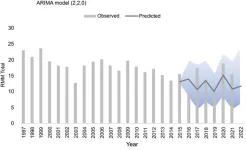(Press-News.org) When people are having a conversation, they rapidly take turns speaking and sometimes even interrupt. Now, researchers who have collected the largest ever dataset of chimpanzee “conversations” have found that they communicate back and forth using gestures following the same rapid-fire pattern. The findings are reported on July 22 in the journal Current Biology.
“While human languages are incredibly diverse, a hallmark we all share is that our conversations are structured with fast-paced turns of just 200 milliseconds on average,” said Catherine Hobaiter (@NakedPrimate) at the University of St Andrews, UK. “But it was an open question whether this was uniquely human, or if other animals share this structure.”
“We found that the timing of chimpanzee gesture and human conversational turn-taking is similar and very fast, which suggests that similar evolutionary mechanisms are driving these social, communicative interactions,” says Gal Badihi (@Gal_Badihi), the study’s first author.
The researchers knew that human conversations follow a similar pattern across people living in places and cultures all over the world. They wanted to know if the same communicative structure also exists in chimpanzees even though they communicate through gestures rather than through speech. To find out, they collected data on chimpanzee “conversations” across five wild communities in East Africa.
Altogether, they collected data on more than 8,500 gestures for 252 individuals. They measured the timing of turn-taking and conversational patterns. They found that 14% of communicative interactions included an exchange of gestures between two interacting individuals. Most of the exchanges included a two-part exchange, but some included up to seven parts.
Overall, the data reveal a similar timing to human conversation, with short pauses between a gesture and a gestural response at about 120 milliseconds. Behavioral responses to gestures were slower. “The similarities to human conversations reinforce the description of these interactions as true gestural exchanges, in which the gestures produced in response are contingent on those in the previous turn,” the researchers write.
“We did see a little variation among different chimp communities, which again matches what we see in people where there are slight cultural variations in conversation pace: some cultures have slower or faster talkers,” Badihi says.
“Fascinatingly, they seem to share both our universal timing, and subtle cultural differences,” says Hobaiter. “In humans, it is the Danish who are ‘slower’ responders, and in Eastern chimpanzees that’s the Sonso community in Uganda.”
This correspondence between human and chimpanzee face-to-face communication points to shared underlying rules in communication, the researchers say. They note that these structures could trace back to shared ancestral mechanisms. It’s also possible that chimpanzees and humans arrived at similar strategies to enhance coordinated interactions and manage competition for communicative “space.” The findings suggest that human communication may not be as unique as one might think.
“It shows that other social species don’t need language to engage in close-range communicative exchanges with quick response time,” Badihi says. “Human conversations may share similar evolutionary history or trajectories to the communication systems of other species suggesting that this type of communication is not unique to humans but more widespread in social animals.”
In future studies, the researchers say they want to explore why chimpanzees have these conversations to begin with. They think chimpanzees often rely on gestures to ask something of one another.
“We still don’t know when these conversational structures evolved, or why!” Hobaiter says. “To get at that question we need to explore communication in more distantly related species—so that we can work out if these are an ape-characteristic, or ones that we share with other highly social species, such as elephants or ravens.”
###
Current Biology, Badihi et al. “Chimpanzee gestural exchanges share temporal structure with human language” https://cell.com/current-biology/abstract/S0960-9822(24)00761-9
Current Biology (@CurrentBiology), published by Cell Press, is a bimonthly journal that features papers across all areas of biology. Current Biology strives to foster communication across fields of biology, both by publishing important findings of general interest and through highly accessible front matter for non-specialists. Visit http://www.cell.com/current-biology. To receive Cell Press media alerts, contact press@cell.com.
END
An international team of researchers, including a Northwestern University chemist, has discovered that metallic minerals on the deep-ocean floor produce oxygen — 13,000 feet below the surface.
The surprising discovery challenges long-held assumptions that only photosynthetic organisms, such as plants and algae, generate Earth’s oxygen. But the new finding shows there might be another way. It appears oxygen also can be produced at the seafloor — where no light can penetrate — to support the oxygen-breathing (aerobic) sea life living in complete darkness.
The ...
About The Study: The results of this cohort study suggest that prenatal cannabis use was associated with several adverse maternal health outcomes during pregnancy. Continued research is needed to understand whether characteristics of prenatal cannabis use (e.g., dose, mode, and timing) moderate these associations.
Corresponding Author: To contact the corresponding author, Kelly C. Young-Wolff, Ph.D., M.P.H., email kelly.c.young-wolff@kp.org.
To access the embargoed study: Visit our For The Media ...
About The Study: The findings of this study suggest that sexual and gender minority adults in the U.S. have a disproportionate prevalence of epilepsy. The reasons for this disparity are likely complex and may be associated with biological and psychosocial determinants of health unique to this population; as such, these individuals are in need of protected access to medical care.
Corresponding Author: To contact the corresponding author, Emily L. Johnson, M.D., M.P.H., email ejohns92@jhmi.edu.
To access the embargoed study: Visit our For The Media website at this link https://media.jamanetwork.com/
(doi:10.1001/jamaneurol.2024.2243)
Editor’s ...
About The Study: In this randomized clinical trial, overground robot-assisted gait training using a wearable robot significantly improved gross motor function and gait pattern. This new torque-assisted wearable exoskeletal robot, based on assist-as-needed control, may complement standard rehabilitation by providing adequate assistance and therapeutic support to children with cerebral palsy.
Corresponding Author: To contact the corresponding author, Min-Keun Song, M.D., Ph.D., email drsongmk@chonnam.ac.kr.
To access the embargoed study: Visit our ...
What:
Sexual and gender minorities (SGM)—individuals who identify as gay, lesbian, bisexual, queer, transgender, non-binary, or gender-diverse—are twice as likely to report active epilepsy compared to non-SGM individuals, based on a National Institutes of Health (NIH) analysis of data from the population-based National Health Information Survey. “Active epilepsy” means a person has been diagnosed with epilepsy and has had more than one seizure in the past year or is currently taking anti-seizure medication.
This study suggests that epilepsy could be added to the growing ...
During the peak of the SARS-CoV-2 pandemic, there was an increase in maternal mortality in Chile. This is confirmed by a natural population experiment based on data from the Department of Health Statistics and Information (DEIS) of the Chilean Ministry of Health. The research was published in PLOS Global Public Health.
In a collaborative study, led by Professor Elard Koch, senior epidemiologist and founder of MELISA Institute (Chile), and conducted with a team of researchers from the Universidad Católica Sedes Sapientiae (Peru), the Pontificia Universidad ...
A University of Virginia School of Medicine scientist and other top experts from around the world have developed the first comprehensive guidelines for reporting cutting-edge “precision medicine” research in a bid to improve patient care and health equity for people everywhere.
Precision medicine aims to tailor treatments to individual patients to get the best possible outcomes. It does this by considering many different factors specific to the patient, such as the patient’s genetics, environment, lifestyle and more. But until now there have been no standardized guidelines for reporting precision ...
Research Highlights:
Two new, basic research studies in rodents (mice and rats) analyzed the impacts that alcohol may have on the heart.
In a mouse study, abnormal heart rhythms that can occur after a pattern of repeated simulation of binge drinking may be related to a spike in a stress protein found in the heart. Researchers tested a heart protective molecule to reduce the stress protein spike and the resulting irregular heart rhythms.
In a study using rats that lacked estrogen production to simulate human menopause, alcohol exposure resulted ...
A technology has been developed to decompose refrigerants, a greenhouse gas 1,300 times more potent than carbon dioxide, using challenging-to-handle industrial waste.
Dr. Ryi, Shin-kun’s research team at the Hydrogen Convergence Materials Lab of the Korea Institute of Energy Research (KIER) has successfully developed a catalyst from industrial waste known as 'red mud,' a byproduct of aluminum production. This catalyst can decompose HFC-134a refrigerant, commonly used in household appliances like air conditioners and refrigerators, with an efficiency of 99%.
* Red Mud: An industrial byproduct remaining after extracting aluminum ...
Tim Rademacher is taking on a sweet new role at the University of Vermont—as the new Scientific Director of UVM’s Proctor Maple Research Center (PMRC). The PMRC is a field research station of the Department of Plant Biology at the University of Vermont, and is the oldest and most renowned maple science research centers in the world. Since 1947 it has produced cutting edge research on maple, supported maple sugar producers, and bolstered maple syrup production in Vermont—and globally.
“I'm very excited to join PMRC with its rich history and its excellent work that has really pushed the industry in the past, says Rademacher, who will start this fall. “I ...






